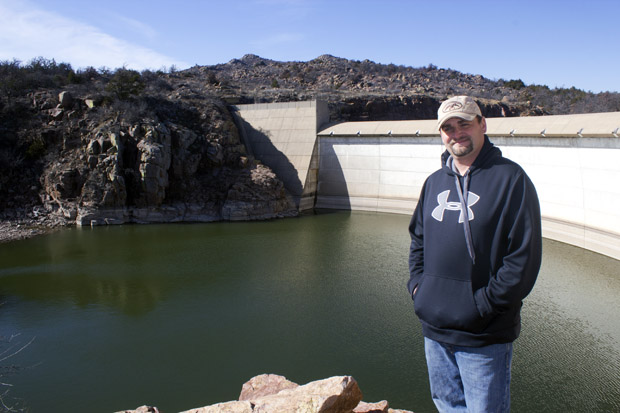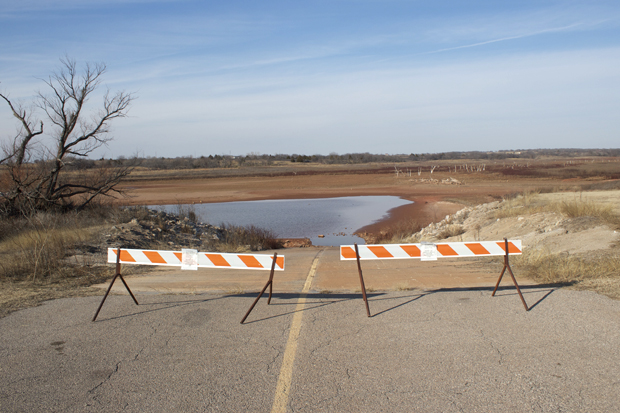
Will Archer, manager of the Mountain Park Master Conservancy District, at the Tom Steed Reservoir dam.
Logan Layden / StateImpact Oklahoma


Will Archer, manager of the Mountain Park Master Conservancy District, at the Tom Steed Reservoir dam.
Logan Layden / StateImpact Oklahoma

Logan Layden / StateImpact Oklahoma
Will Archer, manager of the Mountain Park Master Conservancy District, at the Tom Steed Reservoir dam.
Most of western Oklahoma is in its fifth year of drought with still no end in sight, despite a wetter-than-normal-end to 2014. And many of the lakes communities rely on for drinking water are now on the verge of being too low to use. The situation is most dire in Altus, Duncan and Canton.
The granite boulders and outcroppings that surround Lake Tom Steed, near Altus, are what make is so uniquely beautiful. They also tell a story of drought. The rocks are stained with the remnants of water that used to be here. For lake manager Will Archer, this is all very personal.
“I’ve lived here my whole life, and the creeks I always played on when I was a kid, they don’t run anymore,” Archer says. “Tom Steed is the life and the blood of southwest Oklahoma. Right now we’re providing 100 percent of the water to Altus. We’re providing over half of the water supply to Frederick. We’re providing, I think, about half the water supply to Snyder.”
The lake is in trouble. Only 23 percent of the usable water is left. If nothing is done, Tom Steed could be depleted by November 2016. The rosier outlook has the lake surviving until 2021. The Oklahoma Water Resources Board is working with the federal government on a water study for southwest Oklahoma to determine how much water can be pumped from aquifers, and how best cities can insulate themselves from future droughts.
In the meantime, Altus is widening canals, dusting off its groundwater pumps and rationing. Outdoor watering is allowed only one day a week.

Logan Layden / StateImpact Oklahoma
The dry boat ramp at the Chisholm Trail Ridge Campground on the eastern shore of Waurika Lake.
To the east, the city of Duncan is taking drastic measures to stave off the death of Waurika Lake, which only has about 30 percent of its water still available and could run out by spring 2016.
Duncan is about to ban outdoor water use altogether. At a city council meeting on Tuesday, owners of car washes, nurseries and swimming pool companies asked for exemptions and tried to wrap their heads around what this would mean for business.
Duncan Public Works Director Scott Vaughn, like everyone StateImpact talked to in southwest Oklahoma, is confident Waurika and the city’s other lakes will someday recover. It just doesn’t look like it will be any time soon.
“We have no reason to believe otherwise unfortunately,” Vaughn says. “We’ve not seen any kind of forecast that lead us to believe we’ll have the kinds of rainfall we need to bring those lakes back to normal.”

Logan Layden / StateImpact Oklahoma
Ron Chapdelaine, owner of Canton Foods, says business is down since Canton Lake was tapped by Oklahoma City two years ago.
Canton Lake northwest of the OKC metro is also on the brink. It serves as a backup water source for Oklahoma City, which drained billions of gallons down the North Canadian River to Lake Hefner two years ago. The move has badly damaged tourism and business in the tiny lake town of Canton, where grocery storeowner Ron Chapdelaine is holding his own thanks to the energy industry, or at least he was.
“Wind farms came in, so that brought a lot of people into town, and the oil field obviously with bringing people into town. Now, wind farm’s done, oil field’s done, so we’ve got to hope water comes back up in the lake,” Chapdelaine says.
But the worry from Lou Ann Wooley with the Canton Lake Association is that Oklahoma City will need to take even more water from the reservoir, which is close to being tapped out. The very bottom layer of water in the lake is never supposed to be used, but Wooley says it can be with special permission from the governor.
“It’s a thing they really don’t want to have to face, because if they draw down past the inactive pool you are signing a death warrant for the fish in the lake,” Wooley says. “That recreation, it’ll never rebound from a draw beyond that I don’t think.”
So far, Oklahoma City hasn’t needed more Canton Lake water, but Wooley says that can change quickly. 2015 is critical for all three of these lakes, Tom Steed, Waurika, and Canton. If it doesn’t rain — a lot — they lakes could be lost as a source of water.